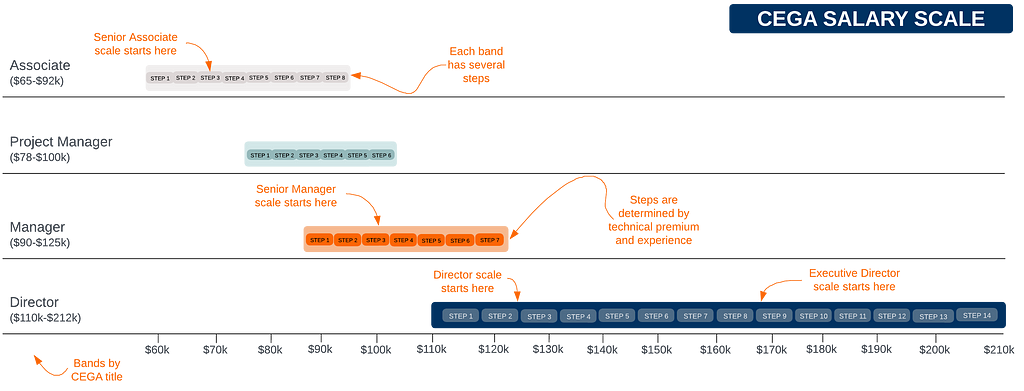A new approach to compensation
In the age of inflation, market volatility, and workforce anomalies, is it possible to compensate employees consistently and fairly? Why does it matter? Lauren Russell, Director of Operations, shares how and why CEGA adopted a transparent pay equity model, and what’s required to sustain it.

Have you ever felt the need to negotiate your salary, or learned that a colleague with a similar scope and experience makes significantly more than you? As a hiring manager, have you ever had to make impromptu decisions about pay or engage in difficult conversations about how much to compensate a new hire with a competing offer?
While these occurrences are common, research shows that salary negotiations disproportionately benefit employees who are white, male, and/or more senior in their careers, and that women and people of color are often penalized for attempting to negotiate their salaries. At CEGA, we wanted to build a culture where salary negotiations were made obsolete by a transparent, equitable, and consistent framework used to make compensation decisions.
Determining our compensation philosophy
To realize this goal, we first needed a clear ideology around how we pay and reward our staff, anchored by our organizational values. CEGA’s new compensation philosophy seeks to ensure that:
- Each employee feels valued and is fairly compensated.
- There is no evidence of pay inequity or discrimination across race, gender, or other identities.
- Current and prospective staff have equal access to information about CEGA’s salary scales and relevant decision-making processes.
- We are able to hire, motivate, and retain the talented staff we need to advance our core mission and organizational goals.
Building a robust, transparent compensation model
Establishing our compensation philosophy was the easy part. Putting it into practice required an overhaul of existing systems including our leveling framework, salary scales, and the criteria we use to make salary decisions, as well as a clear and consistent process for applying these criteria.
We started by carefully reviewing salary data from the University of California, Berkeley (where we sit), the University of California Office of the President (which leverages national labor market data across several sources), and a detailed salary survey of US-based research centers and nonprofits, and used these data as a benchmark for an updated CEGA salary scale (below). The scale now consists of four “bands” corresponding to common titles for our staff (Associate, Project Manager, Program Manager, and Director). Each band has six or more salary “steps” that are used to define where employees are placed on the band and how they will typically advance year over year. Note that the job band for any given role is determined at the beginning of a recruitment, before candidates even apply, and the corresponding salary range is shared transparently in our public-facing job description.

At this stage, we also selected (and defined) two discrete criteria that CEGA uses to determine salary for individual candidates: technical expertise and equivalent experience. “Technical expertise” reflects the specialized expertise, skills, or credentials needed to do a given job, and/or the scarcity of qualified candidates in the market. This criteria is linked to the job itself, not the individual. Meanwhile, “equivalent experience” is defined as “years of experience performing similar job duties or functions (overlap of at least 75%) at a comparable or higher organizational level.” This criteria is assessed based on the candidate’s individual training and experience. By using these two criteria, and applying them consistently, CEGA can now leverage a basic formula to determine the appropriate salary step within the predetermined salary band for any given candidate.
The final product is a simple yet robust compensation model.
Importantly, the transparency of our new model ensures that current and prospective staff have access to all information — shifting the burden of negotiation, increasing CEGA’s accountability, and ultimately reducing bias and subjectivity. See our salary range calculator for specifics on our methodology.
Choices, trade-offs, and paradigm shifts
We made a conscious choice to invest in a new compensation model, with the intention of strengthening pay equity and our ability to recruit and retain talent. But the truth is, there are real trade-offs, and we will need to shift existing paradigms (and business practices) to make our compensation structure sustainable.
Undeniably, there is a funding model elephant in the room, as described by Compass Point in this blog. Most nonprofits and research centers — including CEGA — are not financed to make these kinds of substantial shifts to their business model. Transparency and equity can be costly, particularly for the public and nonprofit sectors which have historically undervalued and underpaid their workforce. CEGA seeks to disrupt these tendencies with our new compensation model. But in order to sustain it long-term, we will need to budget for the true cost of labor in proposals for both programmatic and administrative staff, and secure more general operating support from foundations and private donors.
Reimagining compensation at CEGA and beyond
CEGA’s research leverages rigorous, scientific approaches and we have diffused this ethos across all aspects of our work, including people operations. We initially embarked on our pay equity journey to align internal processes with our organizational values, to create more equitable systems, and to recruit and retain talented staff who can advance our mission — and it evolved into something much more. Now, we hope we can serve as a model for other organizations, within and beyond the global development research community, seeking to advance transparency and pay equity — and this post is one step in promoting CEGA’s compensation model with organizational peers. We also strive to spark conversation among foundations and other supporters of our work around the true cost of labor and the sustainability of updated, accurate cost-structures.
A new approach to compensation was originally published in CEGA on Medium, where people are continuing the conversation by highlighting and responding to this story.

